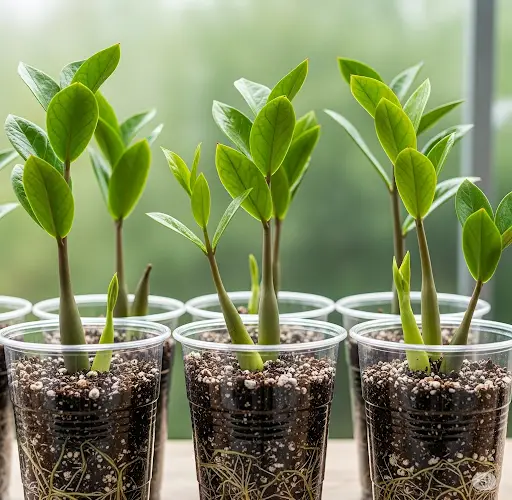Zamioculcas zamiifolia, commonly known as the ZZ plant, is a popular indoor plant admired for its glossy green leaves and remarkable tolerance to neglect. While it’s often praised for being low-maintenance, propagating it can seem like a slow or complicated process—especially for beginners. However, there is one propagation method that stands out for being simple, effective, and surprisingly underused. Once you try it, you’ll wonder why you didn’t do it this way from the beginning!
The Traditional Propagation Methods
ZZ plants can be propagated in several ways, but most common methods include:
-
Leaf cuttings in water or soil
-
Division of the root ball (rhizome splitting)
-
Stem cuttings placed in moist substrate
While all of these methods can work, they often require months of waiting. Leaf cuttings, for example, can take six months or more just to produce small rhizomes, with visible growth appearing even later.
The Best Method: Propagation by Division During Repotting
The most effective and practical way to propagate a ZZ plant is by division during repotting. This method allows you to separate large, healthy sections of the plant and create instantly viable new plants—without the long wait.
Here’s how to do it:
When to Propagate
The best time to propagate your ZZ plant is in the spring or early summer, during its active growing season. This gives the divided plants time to establish themselves before growth slows in the cooler months.
Tools You’ll Need:
-
A clean, sharp knife or garden shears
-
A few empty pots with drainage holes
-
A well-draining soil mix (details below)
-
Gloves (ZZ plant sap can irritate sensitive skin)
Step-by-Step Guide to Propagating by Division
-
Remove the Plant from Its Pot
Gently take the ZZ plant out of its pot. If it’s root-bound, squeeze the sides of the pot or tap it lightly on a surface to loosen the root ball. -
Inspect the Rhizomes
ZZ plants grow from thick, potato-like structures called rhizomes. These store water and nutrients, making the plant so drought-tolerant. Look for natural separations between rhizomes where you can divide the plant without damage. -
Separate the Rhizomes
Using your hands or a clean knife, gently pull or cut apart sections of the plant. Each section should have at least one healthy rhizome and a few leaves or stems attached. Avoid dividing the plant into very small pieces—larger divisions are more likely to thrive. -
Let the Cuts Callus (Optional)
If you had to cut through any part of the rhizome, it’s wise to let the cut surface dry and callus for a few hours before planting. This helps prevent rotting. -
Plant Each Division
Place each division in its own pot filled with a well-draining soil mix. A good mixture includes:-
2 parts potting soil
-
1 part perlite or pumice
-
1 part sand or orchid bark
This combination ensures air can reach the roots and excess water drains quickly.
-
-
Water Sparingly
Water the newly potted sections lightly, just enough to moisten the soil. ZZ plants don’t like wet feet, especially after division. Let the top layer of soil dry out before watering again. -
Place in Indirect Light
Keep the new plants in a bright location with indirect sunlight. Avoid direct sun while the plant recovers and establishes itself in the new pot.
Why This Method Works So Well
Unlike leaf or stem cuttings, division gives you an already-established section of plant complete with roots and rhizomes. It reduces the risk of failure and significantly speeds up the propagation process. Within a few weeks, the new plant will show signs of growth, and within a few months, it may look just as lush as the original.
Extra Care Tips for ZZ Plants
-
Watering: Only water when the top 3–5 cm of soil feels dry. Overwatering is the most common mistake with ZZ plants.
-
Light: ZZ plants tolerate low light but thrive in bright, indirect sunlight.
-
Fertilizer: Feed once a month during the growing season with a balanced, diluted liquid fertilizer.
-
Humidity: ZZ plants do well in average indoor humidity and don’t require misting.
Final Thoughts
If you’ve tried other ZZ plant propagation methods and found them too slow or unpredictable, try division the next time you repot. It’s fast, efficient, and nearly foolproof. Whether you’re expanding your indoor jungle or sharing with friends, this method guarantees success with minimal effort.



